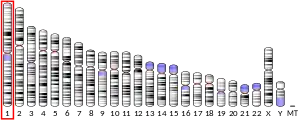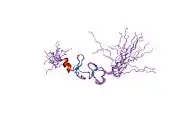FHL3
Four and a half LIM domains protein 3 is a protein that in humans is encoded by the FHL3 gene.[5][6][7]
| FHL3 | |||||||||||||||||||||||||
|---|---|---|---|---|---|---|---|---|---|---|---|---|---|---|---|---|---|---|---|---|---|---|---|---|---|
 | |||||||||||||||||||||||||
| |||||||||||||||||||||||||
| Identifiers | |||||||||||||||||||||||||
| Aliases | FHL3, SLIM2, four and a half LIM domains 3 | ||||||||||||||||||||||||
| External IDs | OMIM: 602790 MGI: 1341092 HomoloGene: 37928 GeneCards: FHL3 | ||||||||||||||||||||||||
| |||||||||||||||||||||||||
| |||||||||||||||||||||||||
| |||||||||||||||||||||||||
| |||||||||||||||||||||||||
| Orthologs | |||||||||||||||||||||||||
| Species | Human | Mouse | |||||||||||||||||||||||
| Entrez | |||||||||||||||||||||||||
| Ensembl | |||||||||||||||||||||||||
| UniProt | |||||||||||||||||||||||||
| RefSeq (mRNA) | |||||||||||||||||||||||||
| RefSeq (protein) | |||||||||||||||||||||||||
| Location (UCSC) | Chr 1: 38 – 38.01 Mb | Chr 4: 124.7 – 124.71 Mb | |||||||||||||||||||||||
| PubMed search | [3] | [4] | |||||||||||||||||||||||
| Wikidata | |||||||||||||||||||||||||
| |||||||||||||||||||||||||
LIM proteins are defined by the possession of a highly conserved double zinc finger motif called the LIM domain.[supplied by OMIM][7]
Function
FHL3 plays a role in myogenesis[8] and also stimulates the development of neural crest by enhancing BMP signaling.[9]
Interactions
FHL3 has been shown to interact with:
References
- GRCh38: Ensembl release 89: ENSG00000183386 - Ensembl, May 2017
- GRCm38: Ensembl release 89: ENSMUSG00000032643 - Ensembl, May 2017
- "Human PubMed Reference:". National Center for Biotechnology Information, U.S. National Library of Medicine.
- "Mouse PubMed Reference:". National Center for Biotechnology Information, U.S. National Library of Medicine.
- Morgan MJ, Madgwick AJ (October 1996). "Slim defines a novel family of LIM-proteins expressed in skeletal muscle". Biochem Biophys Res Commun. 225 (2): 632–8. doi:10.1006/bbrc.1996.1222. PMID 8753811.
- Lee SM, Tsui SK, Chan KK, Kotaka M, Li HY, Chim SS, Waye MM, Fung KP, Lee CY (May 1999). "Chromosomal mapping of a skeletal muscle specific LIM-only protein FHL3 to the distal end of the short arm of human chromosome 1". Somat Cell Mol Genet. 24 (3): 197–202. doi:10.1023/B:SCAM.0000007122.03392.4b. PMID 10226657. S2CID 40511123.
- "Entrez Gene: FHL3 four and a half LIM domains 3".
- Cottle et al., J Cell Sci. 2007 Apr 15;120(Pt 8):1423-35. doi: 10.1242/jcs.004739
- Intracellular enhancement of BMP signaling by LIM-domain protein FHL3 controls spatiotemporal emergence of the neural crest driven by WNT signaling Mansour Alkobtawi, Patrick Pla, Anne H. Monsoro-Burq bioRxiv 711192; doi: https://doi.org/10.1101/711192
- Fimia GM, De Cesare D, Sassone-Corsi P (November 2000). "A family of LIM-only transcriptional coactivators: tissue-specific expression and selective activation of CREB and CREM". Mol. Cell. Biol. 20 (22): 8613–22. doi:10.1128/mcb.20.22.8613-8622.2000. PMC 102166. PMID 11046156.
- Turner J, Nicholas H, Bishop D, Matthews JM, Crossley M (April 2003). "The LIM protein FHL3 binds basic Krüppel-like factor/Krüppel-like factor 3 and its co-repressor C-terminal-binding protein 2". J. Biol. Chem. 278 (15): 12786–95. doi:10.1074/jbc.M300587200. PMID 12556451.
- Li HY, Ng EK, Lee SM, Kotaka M, Tsui SK, Lee CY, Fung KP, Waye MM (2001). "Protein–protein interaction of FHL3 with FHL2 and visualization of their interaction by green fluorescent proteins (GFP) two-fusion fluorescence resonance energy transfer (FRET)". J. Cell. Biochem. 80 (3): 293–303. doi:10.1002/1097-4644(20010301)80:3<293::AID-JCB10>3.0.CO;2-U. PMID 11135358.
- Samson T, Smyth N, Janetzky S, Wendler O, Müller JM, Schüle R, von der Mark H, von der Mark K, Wixler V (July 2004). "The LIM-only proteins FHL2 and FHL3 interact with alpha- and beta-subunits of the muscle alpha7beta1 integrin receptor". J. Biol. Chem. 279 (27): 28641–52. doi:10.1074/jbc.M312894200. PMID 15117962.
Further reading
- Morgan MJ, Madgwick AJ (1999). "The LIM proteins FHL1 and FHL3 are expressed differently in skeletal muscle". Biochem. Biophys. Res. Commun. 255 (2): 245–50. doi:10.1006/bbrc.1999.0179. PMID 10049693.
- Li HY, Ng EK, Lee SM, Kotaka M, Tsui SK, Lee CY, Fung KP, Waye MM (2001). "Protein–protein interaction of FHL3 with FHL2 and visualization of their interaction by green fluorescent proteins (GFP) two-fusion fluorescence resonance energy transfer (FRET)". J. Cell. Biochem. 80 (3): 293–303. doi:10.1002/1097-4644(20010301)80:3<293::AID-JCB10>3.0.CO;2-U. PMID 11135358.
- Turner J, Nicholas H, Bishop D, Matthews JM, Crossley M (2003). "The LIM protein FHL3 binds basic Krüppel-like factor/Krüppel-like factor 3 and its co-repressor C-terminal-binding protein 2". J. Biol. Chem. 278 (15): 12786–95. doi:10.1074/jbc.M300587200. PMID 12556451.
- Mils V, Lee SM, Joly W, Hang EW, Baldin V, Waye MM, Ducommun B, Tsui SK (2003). "LIM-only protein FHL3 interacts with CDC25B2 phosphatase". Exp. Cell Res. 285 (1): 99–106. doi:10.1016/S0014-4827(03)00018-1. PMID 12681290.
- Coghill ID, Brown S, Cottle DL, McGrath MJ, Robinson PA, Nandurkar HH, Dyson JM, Mitchell CA (2003). "FHL3 is an actin-binding protein that regulates alpha-actinin-mediated actin bundling: FHL3 localizes to actin stress fibers and enhances cell spreading and stress fiber disassembly". J. Biol. Chem. 278 (26): 24139–52. doi:10.1074/jbc.M213259200. PMID 12704194.
- Purcell NH, Darwis D, Bueno OF, Müller JM, Schüle R, Molkentin JD (2004). "Extracellular signal-regulated kinase 2 interacts with and is negatively regulated by the LIM-only protein FHL2 in cardiomyocytes". Mol. Cell. Biol. 24 (3): 1081–95. doi:10.1128/MCB.24.3.1081-1095.2004. PMC 321437. PMID 14729955.
- Samson T, Smyth N, Janetzky S, Wendler O, Müller JM, Schüle R, von der Mark H, von der Mark K, Wixler V (2004). "The LIM-only proteins FHL2 and FHL3 interact with alpha- and beta-subunits of the muscle alpha7beta1 integrin receptor". J. Biol. Chem. 279 (27): 28641–52. doi:10.1074/jbc.M312894200. PMID 15117962.
- Takahashi K, Matsumoto C, Ra C (2005). "FHL3 negatively regulates human high-affinity IgE receptor beta-chain gene expression by acting as a transcriptional co-repressor of MZF-1". Biochem. J. 386 (Pt 1): 191–200. doi:10.1042/BJ20040775. PMC 1134781. PMID 15453830.
- Philippar U, Schratt G, Dieterich C, Müller JM, Galgóczy P, Engel FB, Keating MT, Gertler F, Schüle R, Vingron M, Nordheim A (2005). "The SRF target gene Fhl2 antagonizes RhoA/MAL-dependent activation of SRF". Mol. Cell. 16 (6): 867–80. doi:10.1016/j.molcel.2004.11.039. hdl:1721.1/83480. PMID 15610731.
- Rual JF, Venkatesan K, Hao T, Hirozane-Kishikawa T, Dricot A, Li N, Berriz GF, Gibbons FD, Dreze M, Ayivi-Guedehoussou N, Klitgord N, Simon C, Boxem M, Milstein S, Rosenberg J, Goldberg DS, Zhang LV, Wong SL, Franklin G, Li S, Albala JS, Lim J, Fraughton C, Llamosas E, Cevik S, Bex C, Lamesch P, Sikorski RS, Vandenhaute J, Zoghbi HY, Smolyar A, Bosak S, Sequerra R, Doucette-Stamm L, Cusick ME, Hill DE, Roth FP, Vidal M (2005). "Towards a proteome-scale map of the human protein–protein interaction network". Nature. 437 (7062): 1173–8. Bibcode:2005Natur.437.1173R. doi:10.1038/nature04209. PMID 16189514. S2CID 4427026.
- Cottle DL, McGrath MJ, Cowling BS, Coghill ID, Brown S, Mitchell CA (2007). "FHL3 binds MyoD and negatively regulates myotube formation". J. Cell Sci. 120 (Pt 8): 1423–35. doi:10.1242/jcs.004739. PMID 17389685.
External links
- FHL3+protein,+human at the US National Library of Medicine Medical Subject Headings (MeSH)
This article incorporates text from the United States National Library of Medicine, which is in the public domain.
This article is issued from Wikipedia. The text is licensed under Creative Commons - Attribution - Sharealike. Additional terms may apply for the media files.






